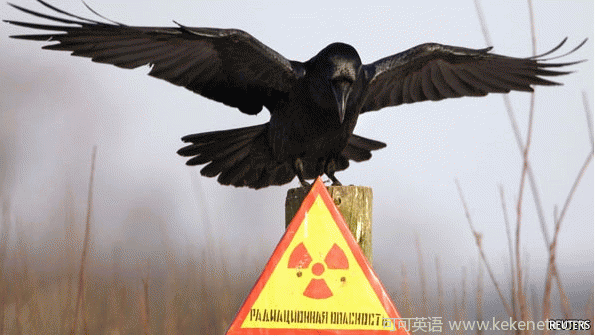
Science and Technolgy.
科技。
Radiation and evolution.
核辐射与进化。
Surviving fallout.
辐射尘中 幸免于难。
Birds can evolve to cope with the lingering effects of nuclear incidents.
鸟类能够通过进化应对核事故的残余影响。
THE disaster last year at the Fukushima Dai-ichi nuclear power plant, caused by an earthquake and tsunami, scored seven on the International Nuclear and Radiological Event Scale (INES). No worse rating exists. Radiation is harmful to living things, yet the long-term effects of persistently high levels of background radiation on ecosystems are poorly understood.With this in mind, a team led by Timothy Mousseau of the University of South Carolina and Anders Moller of the University of Paris-Sud set out to compare bird species dwelling near the Fukushima plant with those living at the site of another nuclear incident that scored a seven on the INES: the Ukrainian town of Chernobyl, where disaster struck in 1986. Remarkably, they found that some species seem to develop a tolerance for radioactivity over time.
去年,地震和海啸引发了福岛第一原子能发电站核泄漏事故,在国际核与辐射事件等级标准(INES)中被评为第七级;没有比这情况还糟的分级了。核辐射对生物有害,而长时间高水平的本底辐射对生态系统有何影响,人们还知之甚少。为了研究这个问题,南卡罗莱纳大学的Timothy Mousseau和巴黎第十一大学的Anders Moller率团队着手比较在两个INES七级事故事发地(福岛核电站和1986年发生事故的乌克兰小镇切尔诺贝利)附近栖息的鸟类种群。结果出人意料。他们发现随着时间迁移,似乎有些鸟类发展出了对核辐射的耐受力。
Fukushima and Chernobyl are more than 7,000km (4,350 miles) apart, but Dr Mousseau and his colleagues soon realised that the two sites had much in common. Both are in areas that have a temperate climate with species that have similar habits and needs. And both are surrounded by a mixture of farmland and forest. Upon closer examination the researchers found that 14 species of bird lived in both regions, including the barn swallow, great tit, great reed warbler, buzzard and Eurasian jay. With so many similarities between the two places, a comparison of the biological responses to radiation in each (recent in Fukushima; long-term in Chernobyl) would surely be illuminating.
福岛和切尔诺贝利相距7,000余公里(4350英里),不过Mousseau和同事们很快发现,两地的鸟类种群有共同之处。两地均属温带气候,周围环绕着农田和森林,鸟类的习性和需求相似。经过进一步调查,研究人员发现两地有14种相同的鸟类,包括家燕、大山雀、大苇莺、鵟、松鸦。既然情况如此相似,比较两地生物对核辐射的反应(福岛:短期反应,切尔诺贝利:长期反应)自然应当具有启发意义。
To do this, during July 2011, the researchers counted and identified birds at 300 locations near Fukushima that had radiation levels as low as 0.5 microsieverts per hour and as high as 35 (for comparison, dental X-rays rarely expose patients to more than 0.05 microsieverts). Then they compared these results to bird data collected in areas that had the same range of radiation levels near Chernobyl between 2006 and 2009.
2011年7月,研究人员清点并鉴定了福岛核电站附近300个地点的鸟类。这些地点的辐射水平低至0.5毫西弗/小时,高至35毫西弗/小时。作为对照,牙医给患者拍X光片的辐射量很少超过0.05毫西弗。他们将结果与在切尔诺贝利周围采集的数据进行了比对。这些数据采集于2006年~2009年间,采集地点的辐射水平与福岛相似。
Their results, published in Environmental Pollution, show that as radiation levels in an area rose to 35 microsieverts per hour, the average number of birds dropped by almost a third compared with the areas where radiation levels were only 0.5 microsieverts per hour. This makes sense: in those areas with a high level of radiation, living things would tend to die or sicken and fail to reproduce. However, when researchers looked at the 14 bird species that lived in both regions, they found that the same level of radiation was associated with twice as large a drop in bird numbers in Fukushima as in Chernobyl.
研究结果发表在《环境污染》杂志上:在辐射水平为35毫西弗/小时的地方,鸟类平均数量比0.5毫西弗/小时的地方少了将近1/3。这是合情合理的:辐射水平高的地方,生物更容易生病死亡,更难繁衍后代。但是,当研究者比对两地共有的14种鸟类时,发现在同样的辐射水平下,福岛的鸟类下降数量几乎达到了切尔诺贝利的两倍。
The reasons for this are not clear. It is possible that the composition of the radionuclides are proving more dangerous to the Fukushima birds than they are to the birds near Chernobyl. But Dr Mousseau suggests a more likely explanation is that evolution has already been at work near Chernobyl, killing off individual birds that cannot cope with the background radiation and allowing the genes of those that have some tolerance to be passed on. The birds at Fukushima are only beginning to face the evolutionary challenge of living in a radioactive world.
人们还不清楚这个现象的原因。也许是因为福岛的放射性核素成分对鸟类更危险。不过Mousseau博士称,这更可能是因为进化已经在切尔诺贝利周围的鸟群中起作用了。不能适应本底辐射的鸟类死亡,对辐射有耐受力的基因则得以传承。而福岛的鸟类才刚刚开始面对辐射环境中的生存进化挑战。











